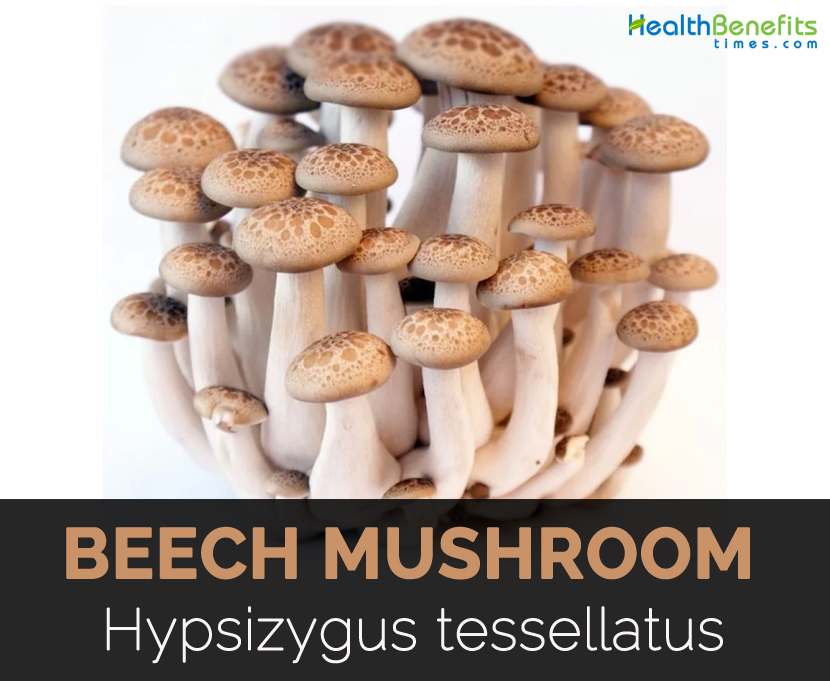Cap
Cap is 4-8 cm, convex and becoming broadly convex with slightly inrolled margin. It is whitish to buff or very pale tan. When fresh and young, it is tessulated with watery spots.
Gills
Gills are close, attached to the stem. Short gills are whitish, frequent and not bruising.
Stem
Stem is equal or slightly club-shaped; bald or very finely silky; 3–8 cm long, 1–2 cm thick and whitish to very pale tan.
Flesh
Flesh is white and white and unchanged when sliced.
Odor and taste
Odor is slightly mealy or distinctive and taste is not distinctive.
Facts about Beech Mushroom
| Beech Mushroom Quick Facts | |
|---|---|
| Name: | Beech Mushroom |
| Scientific Name: | Hypsizygus tessellatus |
| Origin | East Asia |
| Name | Beech Mushroom |
|---|---|
| Scientific Name | Hypsizygus tessellatus |
| Native | East Asia |
| Common/English Name | Buna shimeji, Shimieji, Hon-shimieji, Clamshell, Buna-shimeji, Pioppini, Alba clamshell, Chiodini |
| Climate | Temperate |
| Flavor/aroma | Nutty |
Health Benefits of Beech Mushroom
- Rich in Nutrients
Beech Mushroom has high content of nutrients mainly to polysaccharides as the active compounds. Other nutrients such as fiber, protein and low fat content which is beneficial for those having non-communicable diseases. It contains potassium, phosphorus followed zinc, magnesium and copper. It is a rich in ergosterol steroids, riboflavin, provitamin D2, biotin and niacin.
- Low in cholesterol
Beech mushroom has dietary fiber which promotes fecal excretion of bile acids and reduces insulin response. It lowers serum total cholesterol concentrations but also atherosclerotic lesion formation.
- Prevents parasitic infection
Beech mushrooms have protease enzymes which has nematicidal effect on Panagrellus redivivus and bovine infective larvae which affects animals, plants and humans and protects from parasitic diseases.
- Prevents cancer
Beech Mushroom is rich in glycoprotein (HM-3A), beta-(1-3)-glucan, marmorin, hypsizipreno and hypsin which inhibits proliferation of various cancer cells such as leukemia, breast, hepatoma, sarcoma, lung carcinoma cells. It is a good source of anticancer agents.
- Antifungal properties
Hypsin possess antifungal activity against pathogenic fungi such as Physalospora piricola, Mycospharella arachidicola, Fusarium oxysporum and Botrytis cinerea.
- Treats Hypertension
Beech Mushroom consists of angiotensin I-converting enzyme (ACE) inhibitor which is oligopeptide that lowers blood pressure and reduces the chances of stroke in persons with hypertension.
- Lowers inflammation
Beech Mushroom has high content of phenolic compounds, polysaccharides and flavonoids. It inhibits inflammatory cytokines and oxidative stress and prevents lung failure.
- Prevents bacteria
Beech Mushroom is rich in phenolic and flavonoid content which is beneficial for preventing bacteria such as Escherichia coli, Serratia marcescens, Bacillus subtilis and Staphylococcus aureus.
- Rich in antioxidants
Beech Mushroom has flavonoids, steroids, phenol and ascorbic acid which are biologically active components which prevents oxidative stress mediated disease through radical scavenging activity.
- Diabetes and weight management
Hypsiziprenol, polysaccharides, hypsin and dietary polyphenols found in Beech mushroom helps to lower fat depositions without affecting body weight loss by activating obesity related gene which is associated for oxidation and lipolysis. Moreover, its intake helps to reduce the fasting plasma insulin and plasma glucose, increase antioxidant contents and modulate glycemic index and regulates both insulin resistance and obesity.
Culinary uses
- Add it to stir-fried foods including seafood and wild game.
- Use it in stews, soups and sauces.
- It could be slow roasted on low temperature with small amount of butter or cooking oil.
- Saute mushrooms in olive oil seasoning with soy, green onions, ginger or stock.
- It pairs well with red bell peppers and citrus fruits.
Storage
It could be stored in a refrigerator for 10 days.
References:
https://en.wikipedia.org/wiki/Hypsizygus_tessellatus
https://www.mushroomexpert.com/hypsizygus_tessulatus.html
https://www.revolvy.com/page/Hypsizygus-tessellatus
https://wikivisually.com/wiki/Hypsizygus_tessellatus
https://www.specialtyproduce.com/produce/Hon_Shimeji_White_Beech_Mushrooms_7502.php
https://www.montereymushrooms.com/products/specialty-mushroom-brown-and-white-beech


